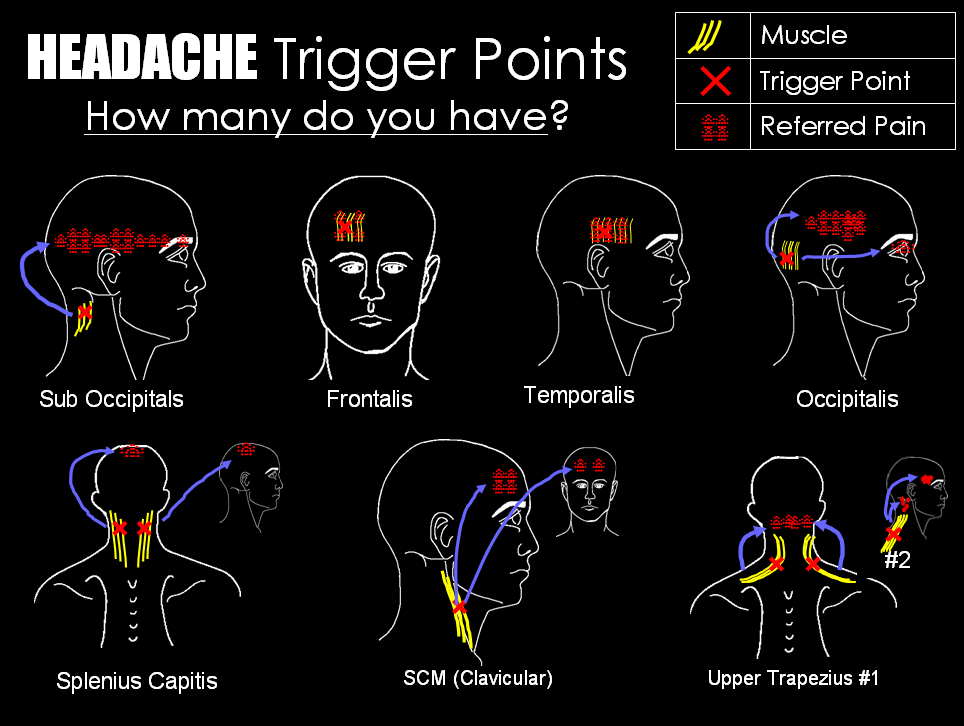A headache is a common and often painful condition that is characterized by pain or discomfort in the head, scalp, or neck. Headaches can range in severity from mild to severe, and can be acute (short-term) or chronic (long-term).

They can be caused by a variety of factors, including tension, stress, dehydration, sinus problems, allergies, eyestrain, hormonal changes, medication overuse, or underlying medical conditions such as migraines or cluster headaches.
Symptoms of a headache can vary depending on the type of headache, but commonly include pain or pressure in the head or neck, sensitivity to light or sound, nausea or vomiting, and fatigue. Treatment options for headaches depend on the underlying cause and may include medications, lifestyle changes, relaxation techniques, or other therapies recommended by a healthcare professional.
There are more than 200 types of headaches. Some are harmless and some are life-threatening. The description of the headache and findings on neurological examination, determine whether additional tests are needed and what treatment is best.
Here is a detailed table classification of headaches based on the International Classification of Headache Disorders (ICHD-3) criteria:
| Type of Headache | Characteristics |
|---|---|
| Tension-type headache (TTH) | – Bilateral location – Pressing or tightening quality – Mild to moderate intensity – Not aggravated by routine physical activity – No nausea or vomiting – No more than one of photophobia (sensitivity to light) or phonophobia (sensitivity to sound) – Duration of 30 minutes to 7 days |
| Migraine without aura | – Unilateral location – Pulsating quality – Moderate to severe intensity – Aggravated by routine physical activity – Associated with nausea and/or vomiting – Photophobia and phonophobia – Duration of 4 to 72 hours |
| Migraine with aura | – Same characteristics as migraine without aura – Preceded by focal neurological symptoms that gradually develop over 5 to 20 minutes and last less than 60 minutes |
| Chronic migraine | – Same characteristics as migraine without aura – Headache occurring on 15 or more days per month for more than three months, with at least eight days per month having features of migraine without aura |
| Cluster headache | – Severe unilateral orbital, supraorbital and/or temporal pain – Lasting 15 to 180 minutes if untreated – Associated with ipsilateral autonomic symptoms (such as conjunctival injection, lacrimation, nasal congestion, rhinorrhea, eyelid edema, or forehead and facial sweating) – Attacks have a frequency of one every other day to eight per day |
| Medication-overuse headache (MOH) | – Headache occurring on 15 or more days per month in a patient with a pre-existing headache disorder – Regular overuse for more than three months of one or more drugs that can be taken for acute and/or symptomatic treatment of headache |
| Rebound headache | – Headache occurring on withdrawal of a previously overused acute or symptomatic medication, or on reducing the dose of the medication |
| Sinus headache | – Pain in the face, forehead, or around the eyes – Associated with nasal congestion and/or discharge – Not fulfilling criteria for migraine or tension-type headache |
| Thunderclap headache | – Severe, sudden-onset headache reaching maximum intensity within 60 seconds to a few minutes |
| Trigeminal neuralgia | – Severe, brief, stabbing, recurrent pain in the distribution of one or more branches of the trigeminal nerve |
| Hemicrania continua | – Continuous unilateral headache with moderate intensity – Occurring for more than three months without shifting sides – Associated with at least one of the following: conjunctival injection, lacrimation, nasal congestion, rhinorrhea, eyelid edema, or forehead and facial sweating |
| New daily persistent headache (NDPH) | – Daily headache that is present from the onset or develops within three days after an abrupt onset – Not fulfilling criteria for other primary headache disorders |
It is important to note that there are many subtypes and variations of headaches within each of these categories, and a thorough medical evaluation by a healthcare professional is necessary to accurately diagnose and treat headaches.

The Signs of a Dangerous Headache Include:
1.A headache that starts suddenly, especially if it’s of a severe degree.
2.Headaches that start later in life, especially after the age of 50.
3.A change in the quality of headaches.
4.Visual changes, including double vision or loss of vision.
5.Weakness, numbness, or any other neurological symptoms.
6.Fevers especially of rapid onset.
7.Change in mental status including sleepiness, hallucinations, speech changes or confusion.
8.Weight loss.
If there is ever ANY doubt about a dangerous headache, your physician should be contacted.
Typically, the migraine patient will notice a fairly consistent set of symptoms and even though the headaches can vary in intensity, the sequence of events is fairly consistent.
Dangerous headaches are the ones that deviate significantly from that migraine sufferers norm. For example, suppose a patients typical migraine is: aura (bright, flashy lights in the visual field or, a strange odor precedes the migraine about 30 min. before the headache strikes), followed by a gradually increasing pain in half of the head which worsens to a point of nausea and sometimes vomiting if something isnt done to stop it (such as a las vegas chiropractic adjustment and/or some form of medication).
If this is that patients usual, IF any of the 8 items previously listed above accompany the headache, it should be further evaluated often requiring an EEG (electroencephalogram) and/or MRI (Magnetic Resonant Image).
The EEG will test for any electrical signal changes in the brain and the MRI will show space occupying structures such as tumors, bleeding, infection, aneurism, and if performed with a contrast agents, arterial malformations (that is, abnormal networks of blood vessels).
Pain Medications, Pain Relief, and Pain Management